TOP 10 recipes for harvesting horseradish for the winter with and without sterilization at home
Summer residents, who are familiar with the culture firsthand, wonder if it is possible to preserve the roots in the winter. This is necessary in order to reinforce it during the period of limited intake of vitamins into the body. Recipes for harvesting horseradish for the winter are simple and uncomplicated, you can make them at home without spending a lot of time and effort.
Useful properties and harm
Before deciding on the preparation of rhizomes for the winter, you should familiarize yourself with the properties of the plant. To whom it is useful, and to whom it is harmful. Only then make a decision on its preparation for future use.

Pros:
- reduces food fermentation in the intestines;
- removes phlegm from the lungs;
- has a choleretic property;
- relieves the symptoms of diabetes;
- resists urolithiasis;
- reduces bleeding gums;
- used for the prevention of oral diseases;
- fights parasites;
- removes excess fluid from the body;
- reduces puffiness;
- treats sprains;
- relieves muscle soreness;
- eliminates boils, mastitis and inflammation;
- normalizes blood pressure;
- fights colds;
- reduces inflammation in the ears;
- helps to increase potency;
- acts as a local anesthetic.
In addition to these advantages, the plant has other useful properties, so the degree of benefit cannot be overestimated. But do not forget about the contraindications or harm from eating horseradish.
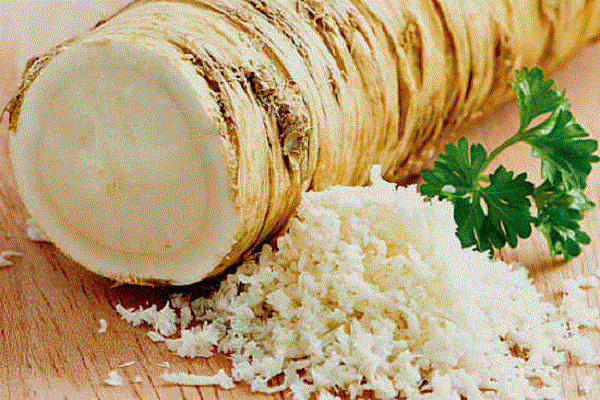
Before use, you should consult with your doctor, especially in the presence of chronic diseases of the kidneys, liver and gastrointestinal tract.
Minuses:
- Negative effect on the mucous membrane.
- In large quantities, it causes a burn in the place to which it was applied, when ingested, it causes an increase in blood pressure, bleeding.
- Not recommended for use by people with diseases of the gastrointestinal tract.
- Cannot be used by children under 8 years old, pregnant and lactating mothers.
- Take with caution to women during menstruation.
Everything is good in moderation, therefore, with self-medication, one should be very careful so that, instead of benefit, it does not cause deterioration. Better to consult a doctor.
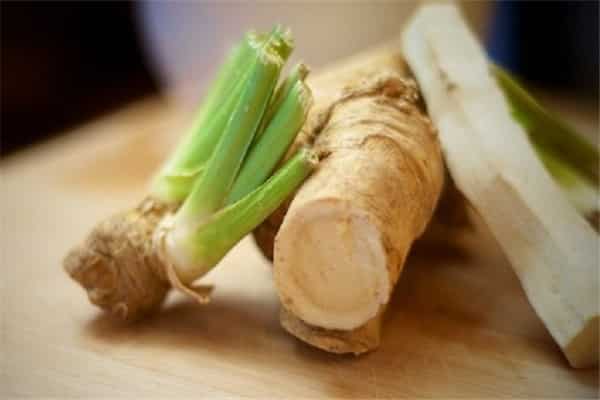
Preparing the main ingredient
To prepare horseradish, you need to properly prepare the root crop for processing.
Tips:
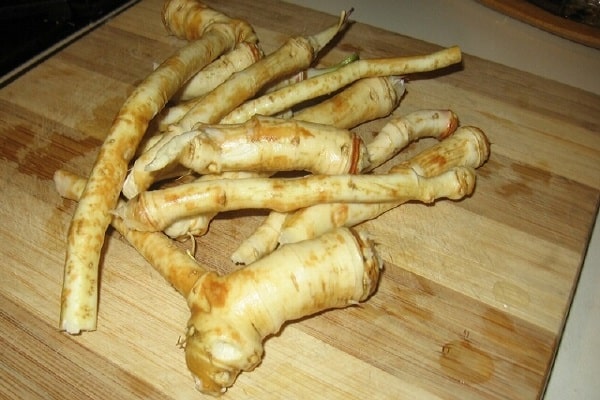
- It is better to dig up the roots just before the processing process. Otherwise, the roots become soft and lose moisture.
- If the horseradish has lain down and lost its presentation, it is soaked in ice water for 24 hours.
- Frozen root vegetables are easier to process.
- When cleaning horseradish, put gloves on your hands, this will prevent burns on your fingers.
- Spices are boldly added to the marinade, this diversifies the taste and adds piquancy. Don't be afraid to experiment.
- When processing a large number of rhizomes, tears cannot be avoided. If the roots are twisted in a meat grinder, just put a plastic bag on it and collect the twisted horseradish into it. Pour into a container with a lid as it fills - this will avoid unpleasant consequences.
By practicing harvesting plant roots every year, housewives gradually reveal their cooking secrets. And they use them in the future from year to year.

Options for harvesting horseradish for the winter
Horseradish harvesting for the winter is truly golden, since the importance of the product cannot be overestimated. Each housewife chooses the way she wants. You just need to determine for yourself the purpose for which the product is procured. For seasoning meat and other dishes or for medicinal purposes.
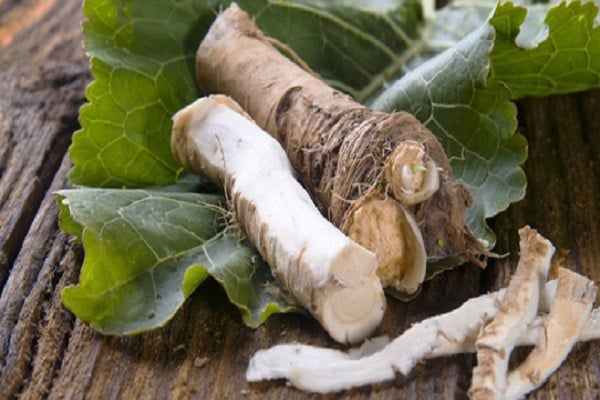
The classic way of canning
The easiest and surest way to preserve horseradish during the winter months is with the classic. For him you will need:
- horseradish;
- water;
- salt;
- sugar;
- vinegar.
Any amount of root is thoroughly washed, peeled and twisted in a meat grinder, you can rub it on a grater. The choice of method depends on the availability of certain kitchen helpers.
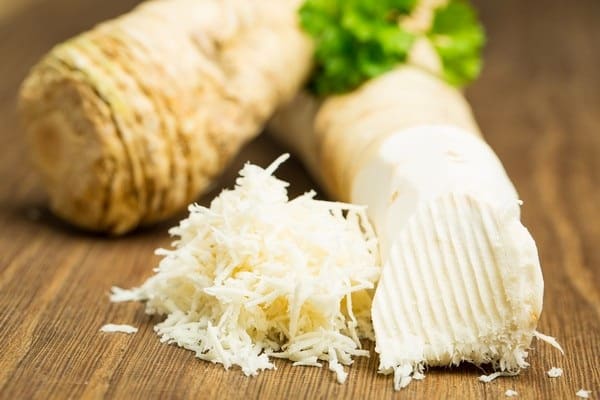
The mass is diluted with water to a state of thick gruel, salted, sugar is added to taste. Pour a small amount of vinegar for preservation and place in sterile containers.
If vinegar is not used, it is replaced with citric acid or lemon juice.
Set for sterilization, the time depends on the volume of the jars: the larger the jar, the more time it takes to sterilize. Estimated time is 5 to 15 minutes.
At the end of the process, they are rolled up and removed until they cool completely in a warm place, under a blanket.
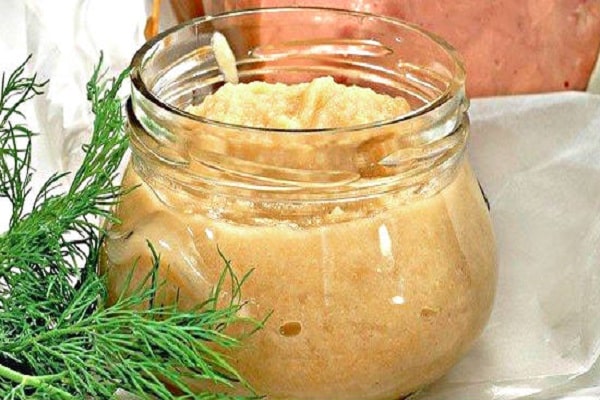
Without sterilization in a jar
Harvesting without heat treatment will help to save more vitamins. The only drawback of this method is the relatively short shelf life. The seasoning will be better kept in the refrigerator.
For cooking you will need:
- horseradish roots;
- garlic;
- tomatoes.

This harvesting method requires 1 kilogram of peeled tomatoes. It is easily separated if vegetables are immersed in boiling water for a few minutes. Then twist the prepared tomatoes in a meat grinder and add 100 grams of garlic to them.
Prepared roots, 300 grams, grate and mix with tomatoes, salt, add granulated sugar for preservation. Mix the mixture well and put in sterile jars. Close with plastic lids. Put the workpiece in the refrigerator.
To make the appetizer spicier, add black pepper and increase the amount of horseradish. On the contrary, to reduce the pungency, the number of crushed roots of the culture is reduced.
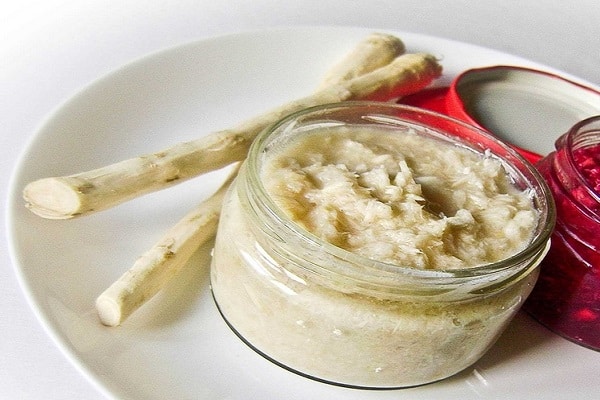
Beetroot recipe
A beautiful and useful blank will turn out if you add beets to horseradish. You don't need to do anything complicated. The main thing is to strictly follow the recipe.
Components:
- horseradish roots - 0.3 kilograms;
- beets - 0.2 kilograms;
- salt - 1 tablespoon;
- sugar - 1 tablespoon;
- vinegar 9% - 0.5 cups;
- water - 2.5 cups.
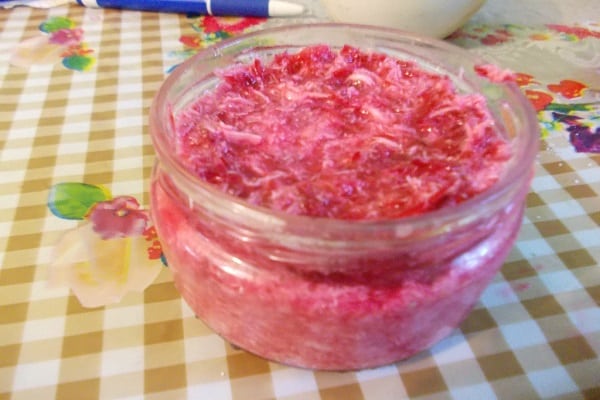
Rinse the roots with cold water. In order for them to be better cleaned and less irritating to the mucous membrane, they are soaked in cold water for a while. Then rub it on a grater. Then pour boiling water and leave to cool gently.
Beets are boiled until tender, peeled and also chopped on a grater. The settled and cooled water is drained from the horseradish. Combine with grated beets and salt the resulting mixture. Sugar and vinegar are added to it. Mix well and put in jars. Close with lids and put in the refrigerator.
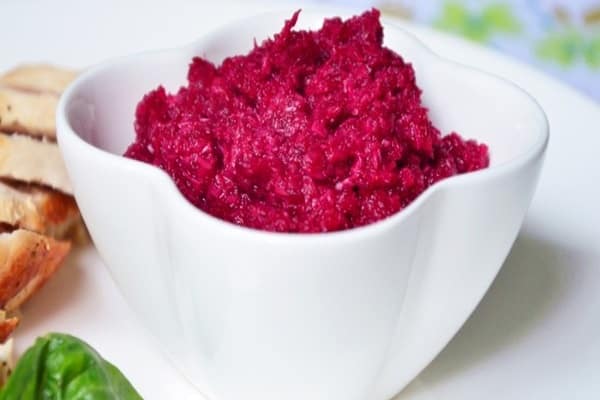
Billet with lime and sea salt
The original way to preserve horseradish. You do not need to replace lime with lemon, this particular fruit is needed. The taste of the ready-made appetizer will amaze the most sophisticated gourmet.
Components:
- horseradish - 500 grams;
- lime zest - 30 grams;
- sea salt - 30 grams;
- black pepper - 30 grams;
- sugar - 40 grams;
- water - 1 liter;
- vinegar 9% - 0.2 liters.

The roots are twisted in a meat grinder. Water is mixed with all the ingredients except horseradish and vinegar. Bring the mixture to a boil, pour in vinegar. After that, the chopped horseradish is mixed well and poured hot into the jars.
They put 1-liter jars for sterilization for 20 minutes, containers smaller in size - for 15 minutes. The finished seasoning is rolled up and removed to cool under a blanket.

Garlic and Tomato Canning
This recipe is easy to follow. It will take a little time to cook it. In winter, this seasoning goes well with meat and fish dishes.
Components:
- horseradish and garlic in equal amounts, at the discretion of the housewife;
- tomatoes - 3 kilograms;
- salt, sugar and pepper to taste.

Tomatoes, root vegetables and garlic are twisted in a meat grinder, spices are added, salted and placed in jars. Put away in the refrigerator. Such a blank is stored a little, you need to take this sign into account when preparing a large volume of snacks.
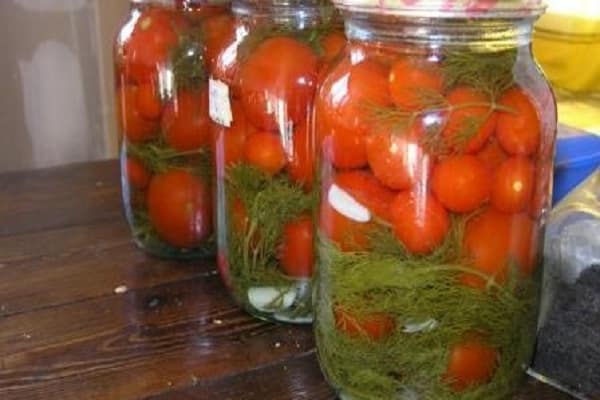
With vinegar
A simple way to extend the shelf life of a product. It will take a minimum of time and ingredients to prepare it.
Components:
- horseradish roots - 0.3 kilograms;
- vinegar 6% - 0.25 liters;
- water - 0.75 liters;
- sugar and salt - 2 teaspoons each;

The roots are grated, poured with boiling water and covered with a lid until they cool completely.
The water is drained, the workpiece is salted and sugar is added. Mix well, then pour the vinegar. Re-mix the ingredients. Packaged in jars and put away in the cold. It's easy to cook, the main thing is to follow all the instructions.

Snack with carrots and apples
The ratio of products is set by the housewives themselves, based on individual preferences. You can prepare such a snack in any volume.
Components:
- horseradish roots;
- carrot;
- apples;
- water;
- salt;
- sugar.
Vegetables are chopped and mixed, laid out in jars. Meanwhile, the marinade is being prepared. For 1 liter of liquid, 1 teaspoon of salt, 1 heaped teaspoon of granulated sugar. Let it boil and pour the prepared containers. Then they are sterilized for 30 minutes. If horseradish is preserved in this way, it will retain most of the vitamins.
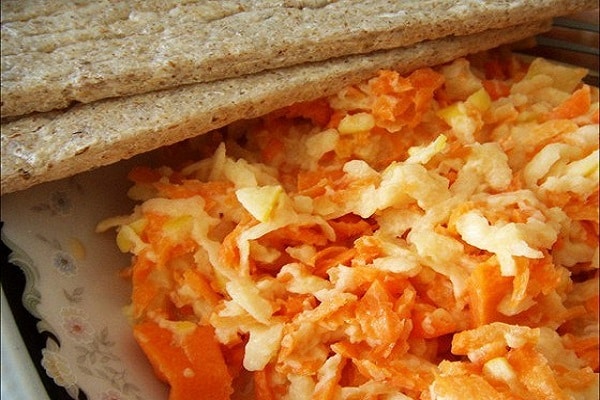
With mayonnaise
Fast preparation of horseradish for storage. For its preparation, you only need horseradish and mayonnaise, in a 1: 2 ratio. The roots are grated and mixed thoroughly with mayonnaise. The resulting sauce is refrigerated.
The advantage of this method is that you can cook a little. The root should be stored in the freezer and thawed before eating.
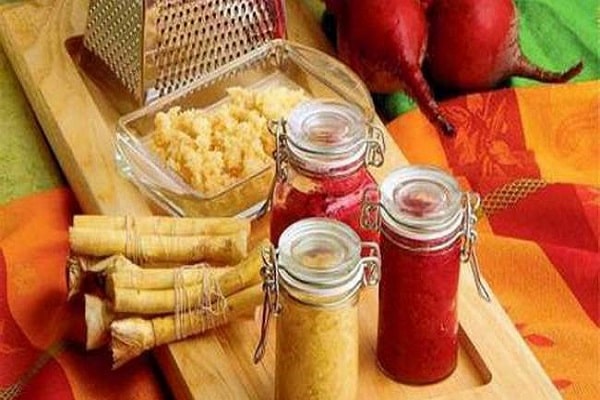
Marinated
A tasty and quick way to harvest horseradish in the winter. Marinating in this way is very simple.
Components:
- horseradish roots - 2.3 kilograms;
- 10 grams of salt;
- 25 grams of sugar;
- 75 milliliters of vinegar.
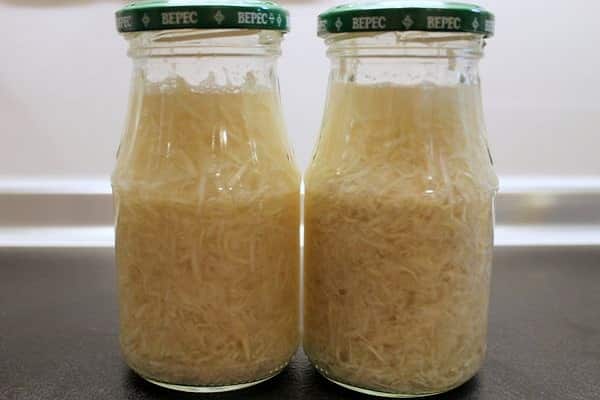
The roots are crushed in a convenient way, laid on 2/3 of a sterile container. It is advisable, for convenience, to use 3 liter cans. Pour into it, on top of the rhizomes, 1.7 liters of boiling water. Add to it 1 tablespoon of salt and sugar and vinegar. Shake well and let cool. Then put in smaller jars and put in the cold.
Marinating horseradish and preserving useful properties is not difficult, it is enough to choose the right recipe.

Freezing roots
To preserve the roots, they must be frozen. To do this, carefully washed roots are peeled and cut into pieces that are convenient for processing. Then they are folded into bags and put into the freezer. There horseradish is able to be stored for a long time, completely preserving the beneficial properties.
Just do not need to constantly expose them to defrosting and re-freezing - the fruit loses its benefits.
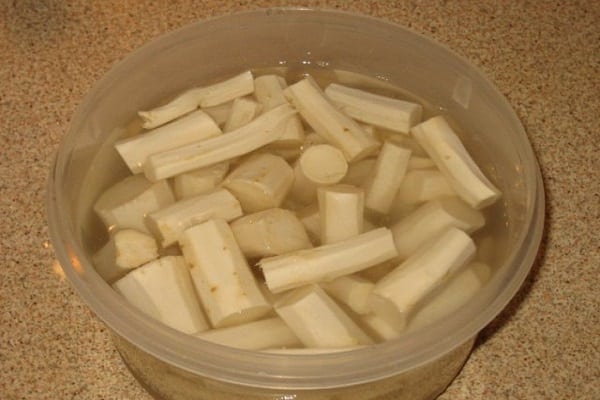
Drying
For those who do not have the opportunity to prepare root crops in other ways, summer residents are advised to simply dry the root.
It is recommended to well clean the root of the residual soil, then gently get rid of the skin and wash the roots. Wipe them off with a towel, grate or chop in another way and put in the oven.
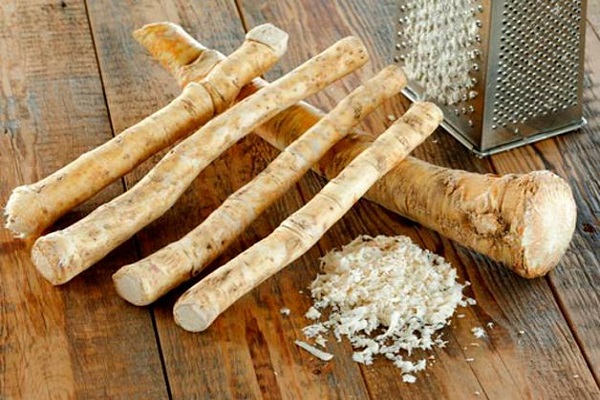
The temperature is set at 40-45 ° C. Keep the crushed roots at this temperature for 2-3 hours. The dried composition is stored in a clean container. The storage place is selected dry and dark.
Dry not only the roots, but also the leaves of horseradish. They are no less useful for humans. Do this in a well-ventilated area, but not in the sun. The dried material is crushed and placed in a glass container. Store until it is useful for use, but no more than 2 years.

How to save horseradish
Storing plant roots is not easy. But if you do everything right, then you can save it until the end of winter and longer, depending on the chosen preservation method.
There are the following ways to preserve roots in winter:
- fresh in the cellar;
- drying;
- freezing;
- salting;
- canning;
- sterilization.
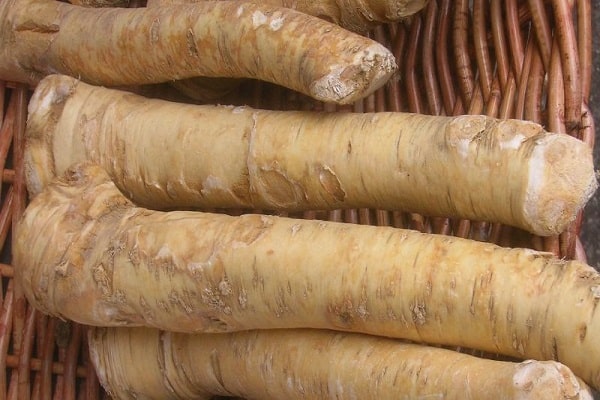
When using a certain method of preserving the product, the shelf life changes. Certain rules must be followed in order for the root to be kept fresh.
- Root crops - 2-3 years. Younger ones do not have the necessary taste characteristics. Old roots are rough.
- You cannot completely cut off the tops, you need to leave 2-3 centimeters.
- Rhizomes are dug in late autumn, when the tops are completely dry.
- The roots for fresh storage are selected without damage or visible signs of disease.
- Without special processing, horseradish is stored for 3 weeks without losing its presentation.
- Each root stored in the refrigerator needs individual packaging.
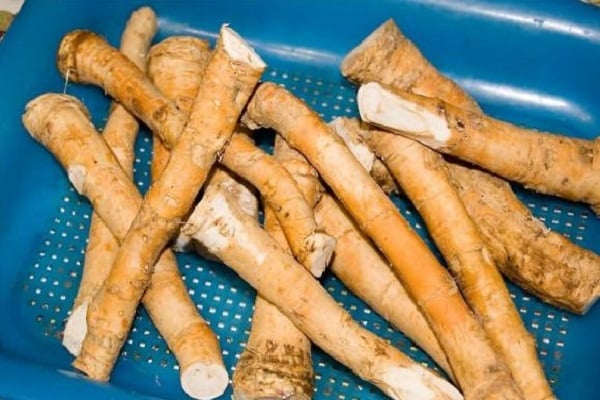
River sand will help preserve the root in the cellar. They take it not very small, pour it on the bottom of a storage container, 7-10 centimeters high. The roots are laid out on it. Each one individually, covered with a layer of sand on top, and so on until the container is full.
Horseradish has a beneficial effect on the human body, so it is recommended to keep it for the winter in any convenient form.
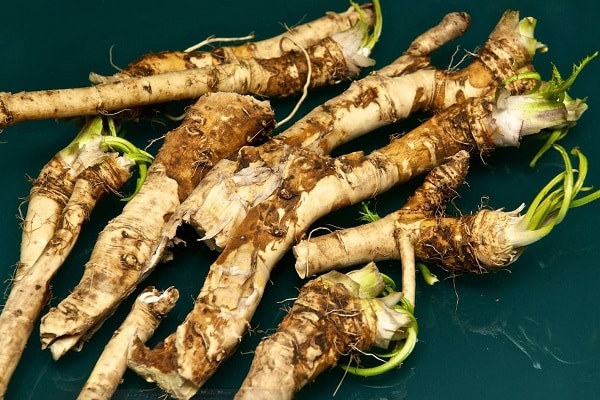

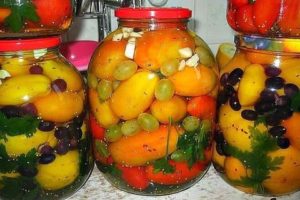
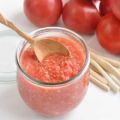
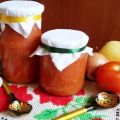
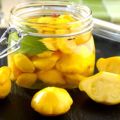
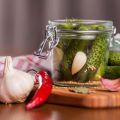


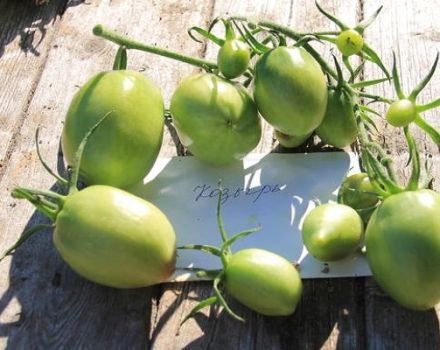
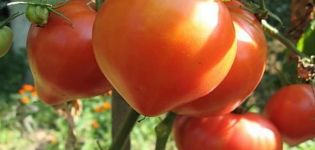
Excellent 5 points